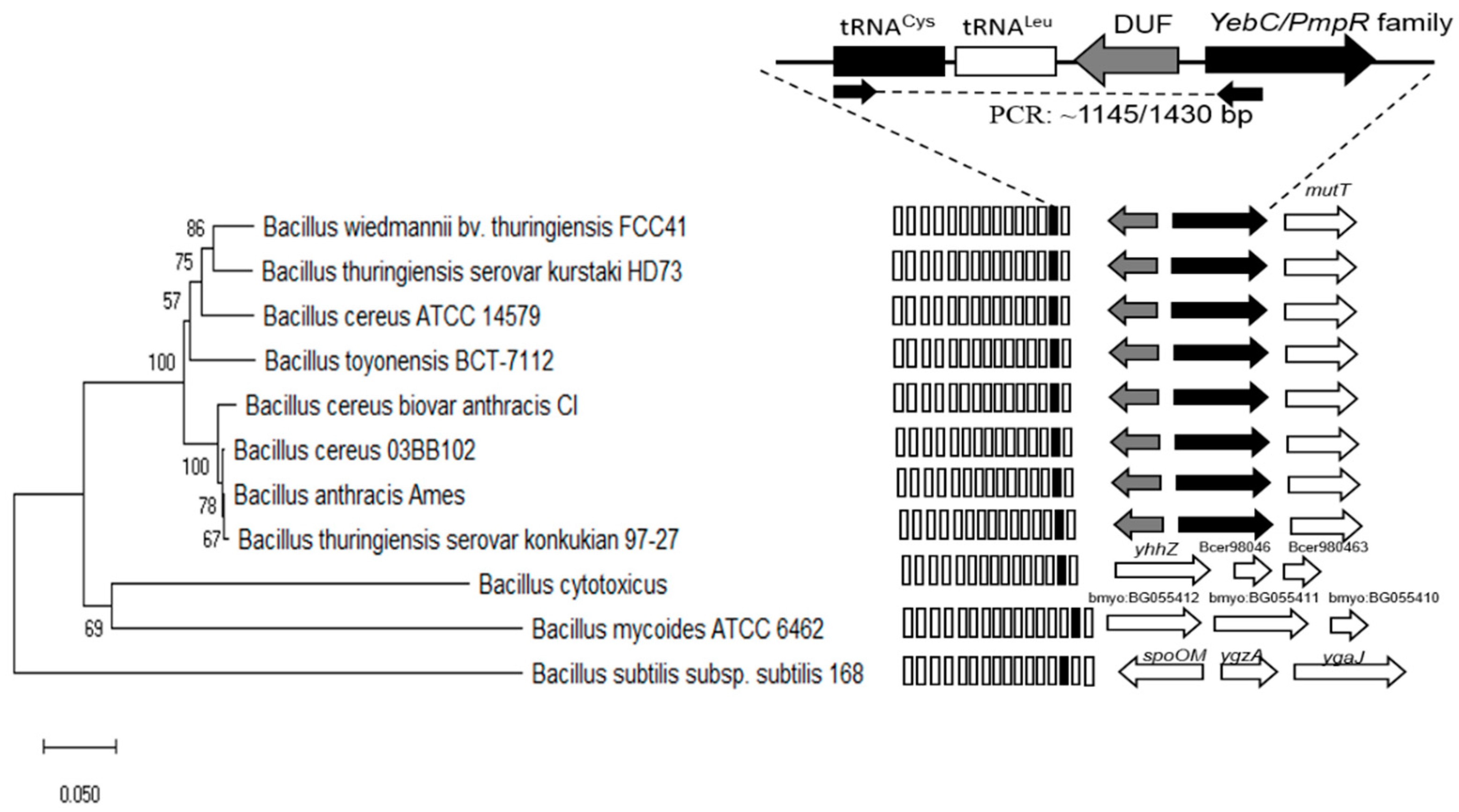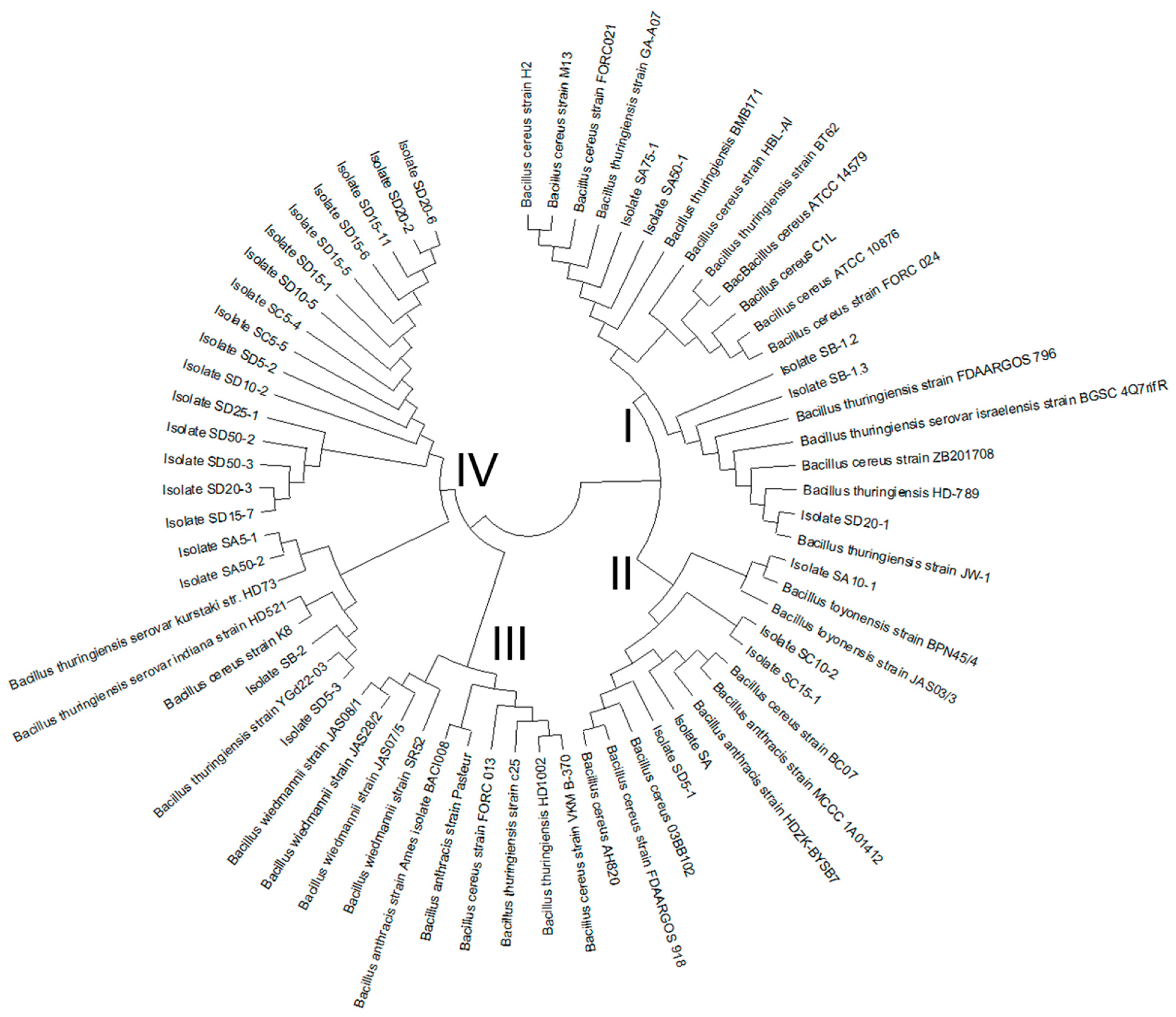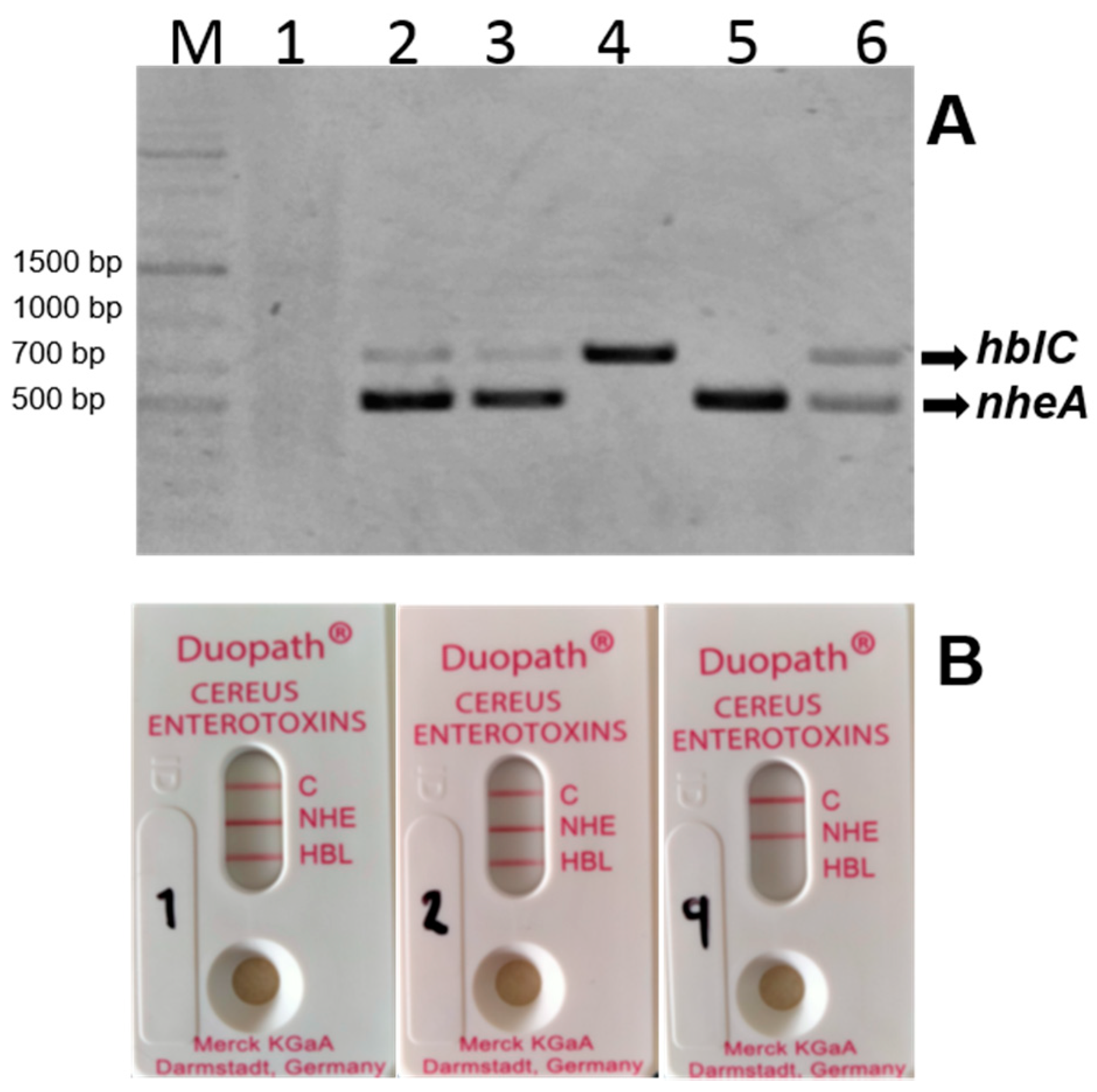Detection of Bacillus cereus sensu lato Isolates Posing Potential Health Risks in Mexican Chili Powder †
Abstract
:1. Introduction
2. Materials and Methods
2.1. Ampicillin-Resistant Detection of B. cereus s.l.
2.2. tRNACys Region Amplification Conditions
2.3. Duopath® Test for Detection of Nhe and Hbl Bacterial TOXIN Formation
2.4. Antibiotic Susceptibility Testing
3. Results
3.1. SMB and B. cereus s.l. Determination
3.2. Phylogenetic Analysis
3.3. Toxigenic Characteristics
3.4. Antibiotic Resistance
4. Discussion
5. Conclusions
Author Contributions
Funding
Conflicts of Interest
References
- Baenas, N.; Belović, M.; Ilic, N.; Moreno, D.A.; García-Viguera, C. Industrial use of pepper (Capsicum annum L.) derived products: Technological benefits and biological advantages. Food Chem. 2019, 274, 872–885. [Google Scholar] [CrossRef] [PubMed]
- Aguilar-Rincón, V.H.; Corona Torres, P.T.; López López, L.; Latournerie Moreno, M.; Ramírez Meraz, H.; Villalón Mendoza, Y.J.; Aguilar Castillo, A. Los chiles de México y su distribución. Rev Fitotecnia Mex SINAREFI, Colegio de Postgraduados; INIFAP, ITConkal, UANL, UAN: Montecillo, Texcoco, Estado de México, Mexico, 2010; p. 114. [Google Scholar]
- Padilha, H.K.M.; Pereira, E.D.S.; Munhoz, P.C.; Vizzotto, M.; Valgas, R.A.; Barbieri, R.L. Genetic variability for synthesis of bioactive compounds in peppers (Capsicum annuum) from Brazil. Food Sci. Technol. 2015, 35, 516–523. [Google Scholar] [CrossRef] [Green Version]
- De Azevedo-Meleiro, C.H.; Rodriguez-Amaya, D.B. Qualitative and quantitative differences in the carotenoid composition of yellow and red peppers determined by HPLC-DAD-MS. J. Sep. Sci. 2009, 32, 3652–3658. [Google Scholar] [CrossRef]
- Eggersdorfer, M.; Wyss, A. Carotenoids in human nutrition and health. Arch. Biochem. Biophys. 2018, 652, 18–26. [Google Scholar] [CrossRef] [PubMed]
- Garcia-Gaytan, V.; Gómez-Merino, F.C.; Trejo-Téllez, L.I.; Baca-Castillo, G.A.; García-Morales, S. The Chilhuacle Chili (Capsicum annuum L.) in Mexico: Description of the Variety, Its Cultivation, and Uses. Int. J. Agron. 2017, 2017, 1–13. [Google Scholar] [CrossRef] [Green Version]
- Molnár, H.; Bata-Vidács, I.; Baka, E.; Cserhalmi, Z.; Ferenczi, S.; Tömösközi-Farkas, R.; Adányi, N.; Székács, A. The effect of different decontamination methods on the microbial load, bioactive components, aroma and colour of spice paprika. Food Control 2018, 83, 131–140. [Google Scholar] [CrossRef]
- Feroz, F.; Shimizu, H.; Nishioka, T.; Mori, M.; Sakagami, Y. Bacterial and Fungal Counts of Dried and Semi-Dried Foods Collected from Dhaka, Bangladesh, and Their Reduction Methods. Biocontrol Sci. 2016, 21, 243–251. [Google Scholar] [CrossRef] [Green Version]
- Van Doren, J.M.; Neil, K.P.; Parish, M.; Gieraltowski, L.; Gould, L.H.; Gombas, K.L. Foodborne illness outbreaks from microbial contaminants in spices, 1973–2010. Food Microbiol. 2013, 36, 456–464. [Google Scholar] [CrossRef]
- González, M.G.M.; Romero, S.M.; Arjona, M.; Larumbe, A.G.; Vaamonde, G. Microbiological quality of Argentinian paprika. Rev. Argent. Microbiol. 2017, 49, 339–346. [Google Scholar] [CrossRef]
- Mamun, A.A.; Masuma, A.; Majumder, D.; Ali, M.; Hossen, M.; Maruf, K. Quality assessment of selected commercial brand of chilli powder in Bangladesh. MOJ Food Process Tech. 2016, 3, 70–73. [Google Scholar] [CrossRef]
- Bata-Vidács, I.; Baka, E.; Tóth, Á.; Csernus, O.; Luzics, S.; Adányi, N.; Székács, A.; Kukolya, J. Investigation of regional differences of the dominant microflora of spice paprika by molecular methods. Food Control 2018, 83, 109–117. [Google Scholar] [CrossRef]
- György, É.; Laslo, É.; Antal, M.; András, C.D. Antibiotic resistance pattern of the allochthonous bacteria isolated from commercially available spices. Food Sci. Nutr. 2021, 9, 4550–4560. [Google Scholar] [CrossRef]
- Frentzel, H.; Kraushaar, B.; Krause, G.; Bodi, D.; Wichmann-Schauer, H.; Appel, B.; Mader, A. Phylogenetic and toxinogenic characteristics of Bacillus cereus group members isolated from spices and herbs. Food Control. 2018, 83, 90–98. [Google Scholar] [CrossRef]
- Hariram, U.; Labbé, R. Spore Prevalence and Toxigenicity of Bacillus cereus and Bacillus thuringiensis Isolates from U.S. Retail Spices. J. Food Prot. 2015, 78, 590–596. [Google Scholar] [CrossRef] [PubMed]
- Lehmacher, A.; Bockemühl, J.; Aleksic, S. Nationwide outbreak of human salmonellosis in Germany due to contaminated paprika and paprika-powdered potato chips. Epidemiol. Infect. 1995, 115, 501–511. [Google Scholar] [CrossRef] [PubMed] [Green Version]
- Ehling-Schulz, M.; Lereclus, D.; Koehler, T.M. The Bacillus cereus Group: Bacillus Species with Pathogenic Potential. Microbiol. Spectr. 2019, 7. [Google Scholar] [CrossRef]
- Guinebretière, M.H.; Auger, S.; Galleron, N.; Contzen, M.; De Sarrau, B.; De Buyser, M.L.; Lamberet, G.; Fagerlund, A.; Granum, P.E.; Lereclus, D.; et al. Bacillus cytotoxicus sp. nov. is a new thermotolerant species of the Bacillus cereus Group occasionally associated with food poisoning. Int. J. Syst. Evol. Microbiol. 2012, 63, 31–40. [Google Scholar] [CrossRef]
- Chang, T.; Rosch, J.W.; Gu, Z.; Hakim, H.; Hewitt, C.; Gaur, A.; Wu, G.; Hayden, R.T. Whole-Genome Characterization of Bacillus cereus Associated with Specific Disease Manifestations. Infect. Immun. 2018, 86, e00574-17. [Google Scholar] [CrossRef] [Green Version]
- Lapidus, A.; Goltsman, E.; Auger, S.; Galleron, N.; Ségurens, B.; Dossat, C.; Land, M.L.; Broussolle, V.; Brillard, J.; Guinebretiere, M.-H.; et al. Extending the Bacillus cereus group genomics to putative food-borne pathogens of different toxicity. Chem. Interact. 2008, 171, 236–249. [Google Scholar] [CrossRef] [PubMed]
- Klee, S.R.; Brzuszkiewicz, E.B.; Nattermann, H.; Brüggemann, H.; Dupke, S.; Wollherr, A.; Franz, T.; Pauli, G.; Appel, B.; Liebl, W.; et al. The Genome of a Bacillus Isolate Causing Anthrax in Chimpanzees Combines Chromosomal Properties of B. cereus with B. anthracis Virulence Plasmids. PLoS ONE 2010, 5, e10986. [Google Scholar] [CrossRef] [PubMed]
- Erickson, B.D.; Elkins, C.; Mullis, L.B.; Heinze, T.M.; Wagner, R.D.; Cerniglia, C.E. A metallo-β-lactamase is responsible for the degradation of ceftiofur by the bovine intestinal bacterium Bacillus cereus P41. Vet. Microbiol. 2014, 172, 499–504. [Google Scholar] [CrossRef]
- Luna, V.A.; King, D.S.; Gulledge, J.; Cannons, A.C.; Amuso, P.T.; Cattani, J. Susceptibility of Bacillus anthracis, Bacillus cereus, Bacillus mycoides, Bacillus pseudomycoides and Bacillus thuringiensis to 24 antimicrobials using Sensititre (R) automated microbroth dilution and Etest (R) agar gradient diffusion methods. J. Antimicrob. Chemother. 2007, 60, 555–567. [Google Scholar] [CrossRef] [PubMed] [Green Version]
- Hernández Flores, J.L.; Salinas Landaverde, D.; Pacheco Huerta, Y.; Guerra Castillo, V.L.; Barrios Sánchez, M.D.L.Á.; Arvizu Hernández, I.; Ramos López, M.Á.; Álvarez Hidalgo, E.; Jones, G.H.; Campos Guillén, J. Phylogenetic Analysis of Bacillus cereus sensu lato Isolates from Commercial Bee Pollen Using tRNACys-PCR. Microorganisms 2020, 8, 524. [Google Scholar] [CrossRef] [PubMed] [Green Version]
- Saitou, N.; Nei, M. The neighbor-joining method: A new method for reconstructing phylogenetic trees. Mol. Biol. Evol. 1987, 4, 406–425. [Google Scholar] [CrossRef]
- Felsenstein, J. Confidence Limits on Phylogenies: An Approach Using the Bootstrap. Evolution 1985, 39, 783–791. [Google Scholar] [CrossRef] [PubMed]
- Jukes, T.H.; Cantor, C.R. Evolution of protein molecules. In Mammalian Protein Metabolism; Munro, H.N., Ed.; Academic Press: Cambridge, MA, USA, 1969; pp. 21–132. [Google Scholar]
- Kumar, S.; Stecher, G.; Li, M.; Knyaz, C.; Tamura, K. MEGA X: Molecular Evolutionary Genetics Analysis across Computing Platforms. Mol. Biol. Evol. 2018, 35, 1547–1549. [Google Scholar] [CrossRef]
- Krause, N.; Moravek, M.; Dietrich, R.; Wehrle, E.; Slaghuis, J.; Märtlbauer, E. Performance characteristics of the Duopath® Cereus Enterotoxins assay for rapid detection of enterotoxinogenic Bacillus cereus strains. Int. J. Food Microbiol. 2010, 144, 322–326. [Google Scholar] [CrossRef] [PubMed]
- Hansen, B.M.; Hendriksen, N.B. Detection of Enterotoxic Bacillus cereus and Bacillus thuringiensis Strains by PCR Analysis. Appl. Environ. Microbiol. 2001, 67, 185–189. [Google Scholar] [CrossRef] [Green Version]
- Testing, E.T. Breakpoint Tables for Interpretation of MICs and Zone Diameters. Version 11.0. 2021. Available online: http://www.eucast.org (accessed on 5 July 2021).
- Banerjee, M.; Sarkar, P.K. Microbiological quality of some retail spices in India. Food Res. Int. 2003, 36, 469–474. [Google Scholar] [CrossRef]
- EFSA Panel on Biological Hazards (BIOHAZ). Risks for public health related to the presence of Bacillus cereus and other Bacillus spp. including Bacillus thuringiensis in foodstuffs. EFSA J. 2016, 14, e04524. [Google Scholar]
- Gao, T.; Ding, Y.; Wu, Q.; Wang, J.; Zhang, J.; Yu, S.; Yu, P.; Liu, C.; Kong, L.; Feng, Z.; et al. Prevalence, Virulence Genes, Antimicrobial Susceptibility, and Genetic Diversity of Bacillus cereus Isolated From Pasteurized Milk in China. Front. Microbiol. 2018, 9, 533. [Google Scholar] [CrossRef] [Green Version]
- Godič Torkar, K.; Bedenić, B.; Plecko, V. Antimicrobial susceptibility and the in vitro postantibiotic effects of vancomycin and ciprofloxacin against Bacillus cereus isolates. J. Chemother. 2015, 28, 1973947815Y0000000069. [Google Scholar]




| Sample | SMB a | BC b (0) | BC (5) | BC (10) | BC (15) | BC (20) | BC (25) | BC (50) | BC (75) | BC (100) |
|---|---|---|---|---|---|---|---|---|---|---|
| A | 1.73 × 103 | 200 | 100 | 100 | 100 | 100 | 100 | 100 | ˂100 | ˂100 |
| B | 8.0 × 102 | 100 | ˂100 | ˂100 | ˂100 | ˂100 | ˂100 | ˂100 | ˂100 | ˂100 |
| C | 2.92 × 105 | 600 | 633 | 600 | 666 | 566 | 433 | ˂100 | ˂100 | ˂100 |
| D | 3.24 × 105 | 700 | 600 | 433 | 633 | 533 | 533 | 333 | 233 | ˂100 |
| Strain | Chili Powder Sample | Toxin Production | Toxin Genes | Antibiotics | Susceptible Increased Exposure | |||
| Hbl | Nhe | hblC | nheA | Resistance | Susceptible | |||
| B. cereus ATCC 10876 | − | + | + | + | + | AMP, CAB, CFT, CTX, DCX, PEN, SXT, CDM | AMK, CHL, CIP, GEN, NET, NTF, NFX, TET, VCM | ERY |
| SA | A | − | + | + | + | AMP, CAB, CFT, CTX, DCX, ERY, PEN, SXT, TET | AMK, CHL, CIP, CDM, GEN, NET, NTF, NFX, VCM | |
| SA5-1 | A | + | + | − | − | AMP, CAB, CFT, CTX, DCX, PEN, SXT, CHL, TET | AMK, CIP, GEN, NET, NTF, NFX, VCM | ERY, CDM |
| SA10-1 | A | + | + | + | + | AMP, CAB, CFT, CTX, DCX, ERY, PEN, SXT | AMK, CHL, CIP, CDM, GEN, NET, NTF, NFX, TET, VCM | |
| SA50-1 | A | + | + | + | + | AMP, CAB, CFT, CTX, DCX, PEN, TET, SXT | AMK, CHL, CIP, ERY, GEN, NET, NTF, NFX, VCM | CDM |
| SA50-2 | A | + | + | + | + | AMP, CAB, CFT, CTX, DCX, PEN, TET, SXT, CHL | AMK, ERY, GEN, NET, NTF, NFX, VCM | CIP, CDM |
| SA75-1 | A | + | + | + | + | AMP, CAB, CFT, CTX, DCX, NTF, PEN, TET, SXT | AMK, CHL, CIP, CDM, ERY, GEN, NET, NFX, VCM | |
| SB-2 | B | + | + | + | + | AMP, CAB, CFT, CTX, DCX, ERY, PEN, SXT, TET, CDM | AMK, CHL, NET, NTF, NFX, VCM | CIP, GEN |
| SB-1.2 | B | + | + | + | + | AMP, CAB, CFT, CTX, DCX, ERY, PEN, SXT, TET, CDM | AMK, CHL, NET, NTF, NFX, VCM | CIP, GEN |
| SB-1.3 | B | + | + | + | + | AMP, CAB, CFT, CTX, DCX, ERY, PEN, SXT, TET, CDM | AMK, CHL, NET, NTF, NFX, VCM | CIP, GEN |
| SC5-4 | C | + | + | + | + | AMP, CAB, CFT, CTX, DCX, ERY, PEN, TET, SXT, CDM | AMK, CHL, CIP, NET, NTF, NFX, VCM | GEN |
| SC5-5 | C | + | + | + | + | AMP, CAB, CFT, CTX, DCX, ERY, PEN, TET, SXT, CDM | AMK, CHL, CIP, NET, NTF, NFX, VCM | GEN |
| SC10-2 | C | − | + | + | + | AMP, CAB, CFT, CTX, DCX, ERY, PEN, SXT, TET, CDM | AMK, CHL, NET, NTF, NFX, VCM | CIP, GEN |
| SC15-1 | C | + | + | + | + | AMP, CAB, CFT, CTX, DCX, ERY, PEN, SXT, CDM | AMK, CHL, CIP, GEN, NET, NTF, NFX, TET, VCM | |
| SD5-1 | D | + | + | + | + | AMP, CAB, CFT, CTX, DCX, ERY, PEN, TET, SXT, CDM | AMK, CHL, CIP, NET, NTF, NFX, VCM | GEN |
| SD5-2 | D | + | + | + | + | AMP, CAB, CFT, CTX, DCX, ERY, PEN, TET, SXT, CHL, CDM | AMK, CIP, NET, NTF, NFX, VCM | GEN |
| SD5-3 | D | + | + | + | + | AMP, CAB, CFT, CTX, DCX, PEN, SXT, CHL, TET, CDM | AMK, CIP, NET, NTF, NFX, VCM | GEN, ERY |
| SD10-2 | D | + | + | + | + | AMP, CAB, CFT, CTX, DCX, ERY, PEN, TET, SXT, CHL, CDM | AMK, CIP, GEN, NET, NTF, NFX, VCM | |
| SD10-5 | D | + | + | + | + | AMP, CAB, CFT, CTX, DCX, ERY, PEN, TET, SXT, CHL, CDM | AMK, GEN, NET, NTF, NFX, VCM | CIP |
| SD15-1 | D | + | + | + | + | AMP, CAB, CFT, CTX, DCX, ERY, PEN, TET, SXT, CHL | AMK, CIP, CDM, GEN, NET, NTF, NFX, VCM | |
| SD15-5 | D | + | + | + | + | AMP, CAB, CFT, CTX, DCX, ERY, PEN, TET, SXT, CHL, CDM | AMK, CIP, GEN, NET, NTF, NFX, VCM | |
| SD15-6 | D | + | + | + | + | AMP, CAB, CFT, CTX, DCX, ERY, PEN, TET, SXT, CDM | AMK, CHL, CIP, NET, NTF, NFX, VCM | GEN |
| SD15-7 | D | + | + | + | + | AMK, AMP, CAB, CFT, CTX, DCX, ERY, NET, PEN, TET, SXT, CHL, GEN, CDM | CIP, NTF, NFX, VCM | |
| SD15-11 | D | + | + | + | + | AMK, AMP, CAB, CFT, CTX, DCX, ERY, PEN, TET, SXT, CDM | CHL, GEN, NET, NTF, NFX, VCM | CIP |
| SD20-1 | D | − | + | + | + | AMP, CAB, CFT, CTX, DCX, PEN, TET, SXT, CDM | AMK, CHL, CIP, GEN, NET, NTF, NFX, VCM | ERY |
| SD20-2 | D | + | + | + | + | AMP, CAB, CFT, CTX, DCX, ERY, PEN, TET, SXT, CHL, CDM | AMK, NET, NTF, NFX, VCM, GEN | CIP |
| SD20-3 | D | + | + | + | + | AMP, CAB, CFT, CTX, DCX, ERY, PEN, TET, SXT, CHL, CDM | AMK, NET, NTF, NFX, VCM | CIP, GEN |
| SD20-6 | D | + | + | + | + | AMP, CAB, CFT, CTX, DCX, ERY, PEN, TET, SXT | AMK, CHL, CIP, GEN, NET, NTF, NFX, VCM | CDM |
| SD25-1 | D | + | + | + | + | AMP, CAB, CFT, CTX, DCX, ERY, PEN, TET, SXT, GEN, CDM | AMK, CHL, NET, NTF, NFX, VCM | CIP, |
| SD50-2 | D | + | + | + | + | AMP, CAB, CFT, CTX, DCX, ERY, PEN, TET, SXT, CHL, CDM | AMK, CIP, NET, NTF, NFX, VCM | GEN |
| SD50-3 | D | + | + | + | + | AMP, CAB, CFT, CTX, DCX, ERY, PEN, TET, SXT, CHL, CDM | AMK, CIP, NET, NTF, NFX, VCM, GEN | |
Publisher’s Note: MDPI stays neutral with regard to jurisdictional claims in published maps and institutional affiliations. |
© 2021 by the authors. Licensee MDPI, Basel, Switzerland. This article is an open access article distributed under the terms and conditions of the Creative Commons Attribution (CC BY) license (https://creativecommons.org/licenses/by/4.0/).
Share and Cite
Hernández, A.G.C.; Ortiz, V.G.; Gómez, J.L.A.; López, M.Á.R.; Morales, J.A.R.; Macías, A.F.; Hidalgo, E.Á.; Ramírez, J.N.; Gallardo, F.J.F.; Gutiérrez, M.C.G.; et al. Detection of Bacillus cereus sensu lato Isolates Posing Potential Health Risks in Mexican Chili Powder. Microorganisms 2021, 9, 2226. https://doi.org/10.3390/microorganisms9112226
Hernández AGC, Ortiz VG, Gómez JLA, López MÁR, Morales JAR, Macías AF, Hidalgo EÁ, Ramírez JN, Gallardo FJF, Gutiérrez MCG, et al. Detection of Bacillus cereus sensu lato Isolates Posing Potential Health Risks in Mexican Chili Powder. Microorganisms. 2021; 9(11):2226. https://doi.org/10.3390/microorganisms9112226
Chicago/Turabian StyleHernández, Andrea Guadalupe Celestino, Vannessa Gómez Ortiz, Jackeline Lizzeta Arvizu Gómez, Miguel Ángel Ramos López, José Alberto Rodríguez Morales, Antonio Flores Macías, Erika Álvarez Hidalgo, Jorge Nuñez Ramírez, Francisco Javier Flores Gallardo, María Carlota García Gutiérrez, and et al. 2021. "Detection of Bacillus cereus sensu lato Isolates Posing Potential Health Risks in Mexican Chili Powder" Microorganisms 9, no. 11: 2226. https://doi.org/10.3390/microorganisms9112226
APA StyleHernández, A. G. C., Ortiz, V. G., Gómez, J. L. A., López, M. Á. R., Morales, J. A. R., Macías, A. F., Hidalgo, E. Á., Ramírez, J. N., Gallardo, F. J. F., Gutiérrez, M. C. G., Gómez, S. R., Jones, G. H., Flores, J. L. H., & Guillén, J. C. (2021). Detection of Bacillus cereus sensu lato Isolates Posing Potential Health Risks in Mexican Chili Powder. Microorganisms, 9(11), 2226. https://doi.org/10.3390/microorganisms9112226








